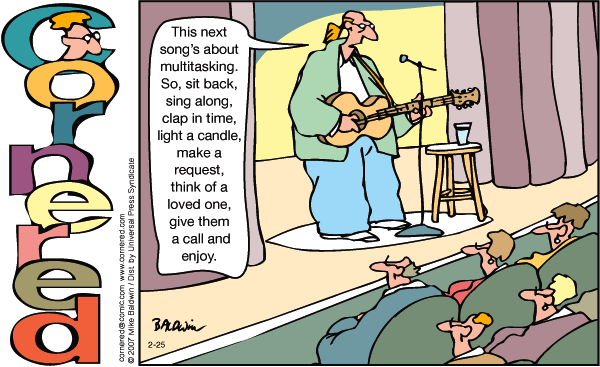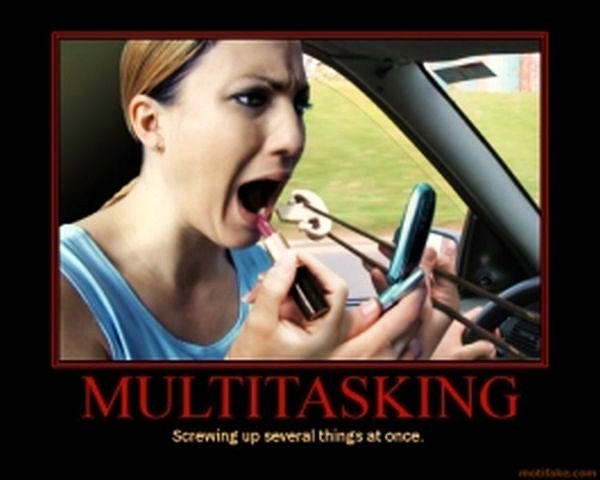
The Myth of Multitasking:
A Researched Reading & Writing Project in Five Phases
Rick Dollieslager / Email: Dollier@tncc.edu

English Comp. and Fundmentals: An Integrated Reading and Writing Project
"Reach for the Sky" Fall Refresher Conference, Phoenix, November 2013: "Integrating Reading and Writing with Student Success Skills: Multitasking and Time Management, a Researched Essay Project." Resources:
|
 |
The Myth of Multitasking: A Researched Reading & Writing Project in Five Phases
Rick Dollieslager / Email: Dollier@tncc.edu |
 |
Objectives: 1] Reading critically. 2] Connecting reading and writing. 3] Modeling the research and research paper writing process. 4] Developing success skills
This project models the research gathering, note-taking and writing processes in a series of steps or phases and culminates in a short, documented essay.
Designed to be taught/learned in five or six class meetings.
Phase One: 1] Reading critically Assignments for the article, “Studies on Multitasking Highlight Value of Self-Control”
1] The Wordle: Consider the vocabulary from the article by viewing the wordle, which is a word jumble. For ten minutes freewrite on these words. Write about the words that you are already familiar with and about what you hope to learn in the article about the other terms. On note paper or a Word document, list the words you do not already know, and leave space for their definitions. 2] While reading, define those vocabulary words on your list as they are meant in the context of the article when you encounter them. Look them up in a dictionary if you are uncertain what they mean from context clues in the article. 3] On a separate note page or Word document, answer the following article analysis questions, after reading, in order to prepare for a) class discussion, b) writing an article summary, and c) using this information in your next essay. Note: Answer the questions in your own words because you will be using those sentences later in a paragraph. If you do this after reading, when the source is closed, there is no risk of plagiarizing. Where you cannot answer the questions from memory, go back to re-read that part of the article. Putting the information in your own words to use in your essay is a research writing skill that is called paraphrasing. In this phase of the project, we will be paraphrasing and condensing the information in order to produce a summary that stays tru to the source.
*Diving deeper to understand the original "Marshmallow Test" and its results: read this article, and view this video, recreating the test with kids. How much better are adults able to defer immediate gratification? 4] Summarizing to avoid plagiarism: Use your answers to the questions above when you write a one-paragraph summary (around 200 words in length) of this article. Watch this video about how to write a summary. Let's discuss summarizing for researched papers, by following this summarizing process. Homework: Vocabulary, answers to reading questions, and one paragraph summarizing the multitasking article. |
||
Phase Two: 2] Connecting reading and writing
5] Group/class discussion: What have been your experiences when multitasking?
6] Writing in class:
Homework: Two paragraphs above, due at the start of next class. |
||
Phase Three: 1] Reading critically, 2] Connecting reading and writing Assignments for the article, “Eisenhower's Urgent/Important Principle: Using Time Effectively, Not Just Efficiently"
7] In class: Previewing reading and note taking. Section your notes sheet into Cornell format and follow the instructions below: (We will all do S and Q together.)
8] Write a summary of the article (about 200 words in length) using your Cornell notes, which are written in your own words if you followed the note-taking instructions, and therefore, they are ready to use, as is. 9] Make a time management matrix which charts your current time use and priorities. Homework: Reading notes, summary of the article, and your time management matrix. |
||
Phase Four: 1] Reading critically, 3] Modeling the research and research paper writing process 10] Group/class discussion: Are you living and working in Quadrant II?
11] Writing in class:
Phase Five: 3] Modeling the research and research paper writing process
12] In class: Let's review the qualities of a good essay. Reconstructing "What I Have Lived For" 13] Writing about multitasking. And now, let's do this revising together. Use the following outline for an essay on multitasking, including your two article summaries and the two personal experience paragraphs you wrote. On the draft, we will add the works cited section and cite the summaries to complete the documentation of sources.
Homework: Finish revising the separate paragraphs into an essay, completing the introductory and concluding paragraphs. It is due at the start of the next class. Next class: Pair-share, peer reviewing the multitasking essay |
Return to R. Dollieslager's home page
![]()
This work is licensed under a Creative Commons Attribution-NonCommercial 3.0 Unported License.